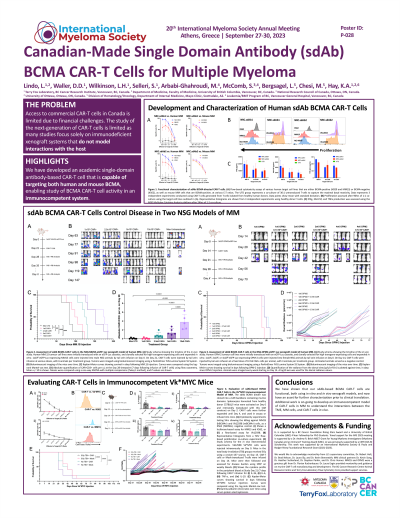Cellular and T cell engager Immunotherapy
Poster Session 1
P-028: Canadian-made single domain antibody (sdAb) BCMA CAR-T cells for Multiple Myeloma
Wednesday, September 27, 2023
1:30 PM - 2:30 PM EEST


Lorenzo Lindo, BSc (he/him/his)
PhD Candidate
Terry Fox Laboratory - BC Cancer Research Institute
Vancouver, British Columbia, Canada
Introduction: Chimeric antigen receptor (CAR)-T cells directed against B-cell maturation antigen (BCMA), have yielded impressive results in clinical trials for multiply relapsed/refractory multiple myeloma (MM). However, progression free survival is short, demonstrating a need for improvements to this therapy.
Methods: To enable novel CAR-T cell designs to address this issue, we developed a single domain antibody (sdAb)-based BCMA CAR construct (sdBCMA.41BB.CD3z) upon which to test our modifications. In vitro characterization of our sdAb-based BCMA-directed CAR T-cells using cells isolated from healthy donors will include cytotoxicity, cytokine release, proliferation, and repetitive stimulation. Following these initial in vitro assays, the novel CAR-T cell constructs will be assessed using xenograft models of human MM. As an example of a modification to BCMA CAR-T cells that would address the immunosuppressive MM tumour microenvironment (TME), a cassette containing a single chain IL-12 (schIL-12) was inserted into our CAR transgene, separated by a 2A skip sequence. To enable the study of the MM TME in response to CAR-T cells, we have also developed a murine version of our CAR-T cell construct and are currently evaluating these CAR-T cells in the transplantable Vk*MYC immunocompetent model of MM.
Results: Using T-cells isolated from human healthy donors, four different sdAb-based BCMA CAR T-cells derived using BCMA sdAbs with varying affinities were tested in co-culture experiments with target cells. When co-cultured with BCMA-expressing target cells, all four CAR-T cells effectively lysed the targets, released inflammatory cytokines, and proliferated. As these short terms in vitro assays showed minimal differences between constructs, longer-term repetitive stimulation to model chronic antigen exposure, paired with immunophenotyping, is underway to identify differences among the constructs. In an NSG xenograft model using MM1S::eGFP cells, administration of one of our constructs, sdBCMA1.41BB.CD3z, CAR T-cells demonstrated a significant improvement in survival and disease control, when compared to control T-cells. Further in vivo testing of the remaining constructs is planned. Insertion of the schIL-12 cassette into the sdBCMA1.41BB.CD3z construct demonstrated effective secretion of IL-12 as detected by ELISA, demonstrating the feasibility of modifications to our sdAb-BCMA CAR-T cells. We provide preliminary evidence of activity in the Vk*MYC model and further work is ongoing to optimize the Vk*MYC model system for murine CAR-T cell evaluation.
Conclusions: We have shown that our sdAb-based BCMA CAR T-cells are functional, both using in vitro and in vivo models, and now have an asset for further characterization prior to clinical translation. Additional work is on-going to develop an immunocompetent model of CAR-T cells in MM to understand the interactions between the TME, MM cells, and CAR-T cells in vivo.
Methods: To enable novel CAR-T cell designs to address this issue, we developed a single domain antibody (sdAb)-based BCMA CAR construct (sdBCMA.41BB.CD3z) upon which to test our modifications. In vitro characterization of our sdAb-based BCMA-directed CAR T-cells using cells isolated from healthy donors will include cytotoxicity, cytokine release, proliferation, and repetitive stimulation. Following these initial in vitro assays, the novel CAR-T cell constructs will be assessed using xenograft models of human MM. As an example of a modification to BCMA CAR-T cells that would address the immunosuppressive MM tumour microenvironment (TME), a cassette containing a single chain IL-12 (schIL-12) was inserted into our CAR transgene, separated by a 2A skip sequence. To enable the study of the MM TME in response to CAR-T cells, we have also developed a murine version of our CAR-T cell construct and are currently evaluating these CAR-T cells in the transplantable Vk*MYC immunocompetent model of MM.
Results: Using T-cells isolated from human healthy donors, four different sdAb-based BCMA CAR T-cells derived using BCMA sdAbs with varying affinities were tested in co-culture experiments with target cells. When co-cultured with BCMA-expressing target cells, all four CAR-T cells effectively lysed the targets, released inflammatory cytokines, and proliferated. As these short terms in vitro assays showed minimal differences between constructs, longer-term repetitive stimulation to model chronic antigen exposure, paired with immunophenotyping, is underway to identify differences among the constructs. In an NSG xenograft model using MM1S::eGFP cells, administration of one of our constructs, sdBCMA1.41BB.CD3z, CAR T-cells demonstrated a significant improvement in survival and disease control, when compared to control T-cells. Further in vivo testing of the remaining constructs is planned. Insertion of the schIL-12 cassette into the sdBCMA1.41BB.CD3z construct demonstrated effective secretion of IL-12 as detected by ELISA, demonstrating the feasibility of modifications to our sdAb-BCMA CAR-T cells. We provide preliminary evidence of activity in the Vk*MYC model and further work is ongoing to optimize the Vk*MYC model system for murine CAR-T cell evaluation.
Conclusions: We have shown that our sdAb-based BCMA CAR T-cells are functional, both using in vitro and in vivo models, and now have an asset for further characterization prior to clinical translation. Additional work is on-going to develop an immunocompetent model of CAR-T cells in MM to understand the interactions between the TME, MM cells, and CAR-T cells in vivo.
